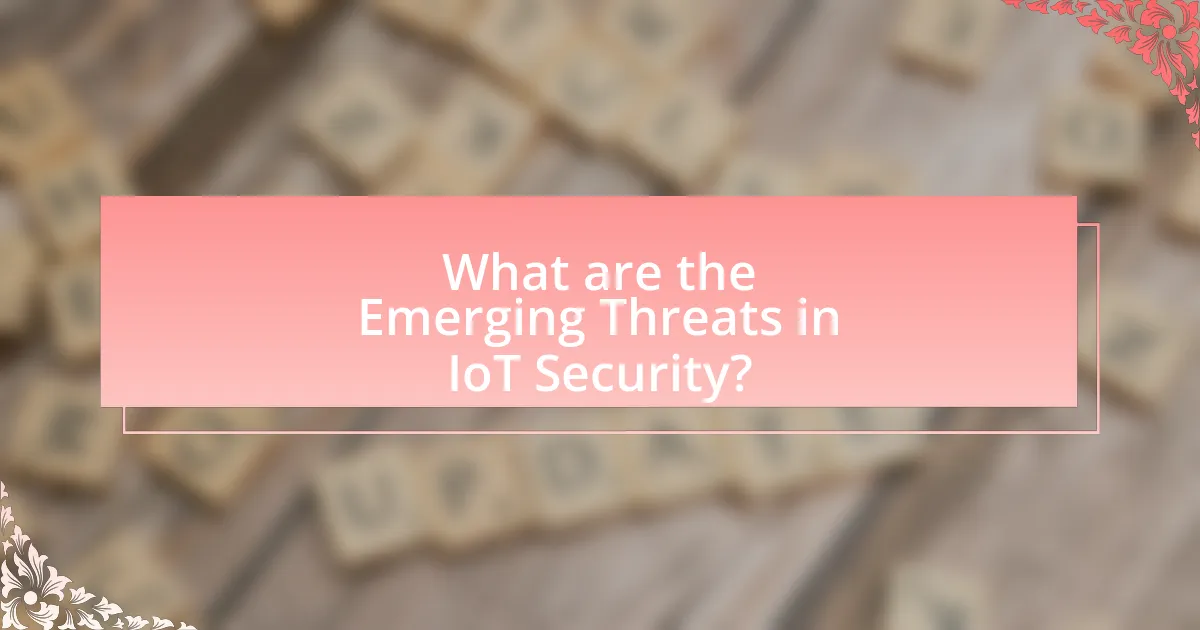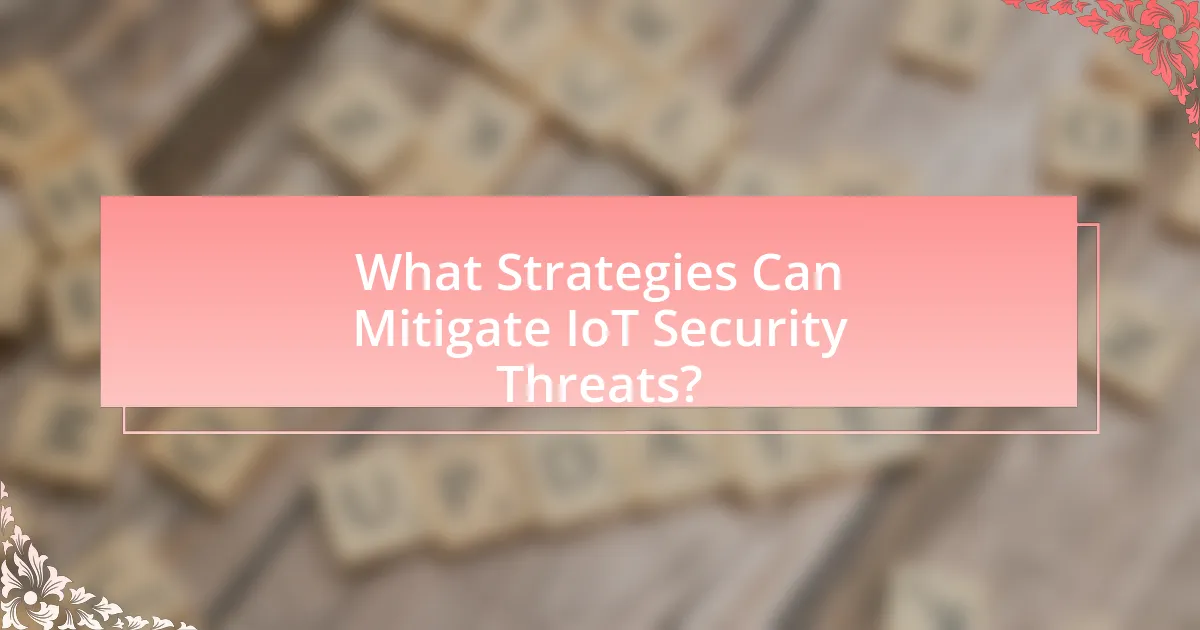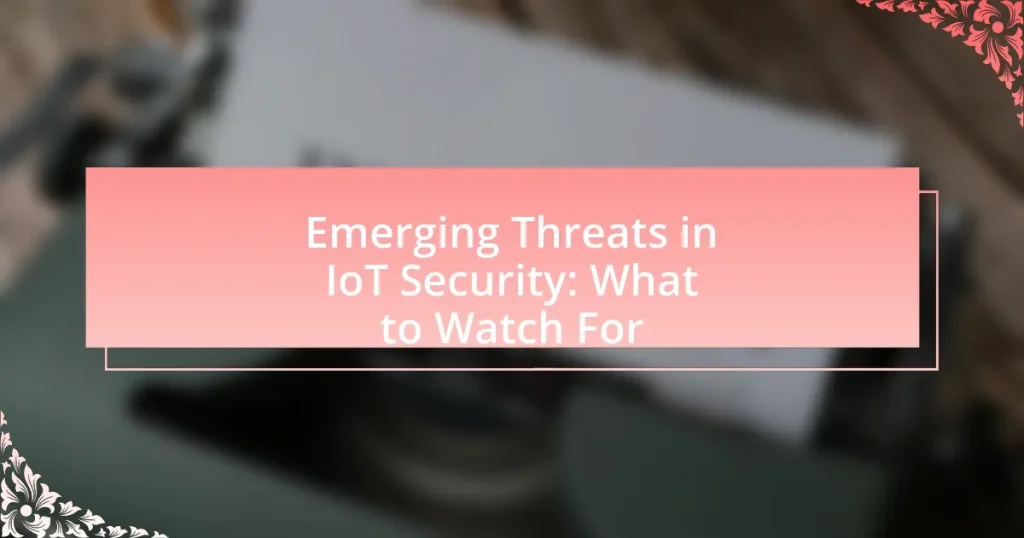The article focuses on the emerging threats in Internet of Things (IoT) security, highlighting significant risks such as botnets, data breaches, and insecure devices. It examines how these threats impact IoT devices and networks, detailing common vulnerabilities exploited by attackers, including weak authentication and outdated software. The discussion extends to the consequences of security breaches, implications for privacy, and the increasing number of connected devices, which amplify security risks. Additionally, the article outlines strategies and best practices for mitigating these threats, emphasizing the importance of strong authentication, regular updates, and network segmentation to enhance IoT security.

What are the Emerging Threats in IoT Security?
Emerging threats in IoT security include botnets, data breaches, and insecure devices. Botnets, such as Mirai, exploit vulnerabilities in IoT devices to launch distributed denial-of-service (DDoS) attacks, demonstrating the potential for widespread disruption. Data breaches occur when sensitive information from connected devices is accessed unlawfully, with incidents like the 2020 Twitter hack highlighting the risks associated with compromised IoT systems. Insecure devices, often lacking proper security measures, can be easily targeted, as evidenced by the increasing number of attacks on smart home devices. These threats underscore the urgent need for enhanced security protocols in the rapidly growing IoT landscape.
How do these threats impact IoT devices and networks?
Emerging threats significantly impact IoT devices and networks by compromising their security, leading to unauthorized access, data breaches, and service disruptions. For instance, a study by the Cybersecurity & Infrastructure Security Agency (CISA) reported that IoT devices are often targeted due to weak authentication protocols, allowing attackers to gain control over devices and exploit them for malicious purposes. Additionally, the proliferation of botnets, such as Mirai, demonstrates how compromised IoT devices can be used to launch Distributed Denial of Service (DDoS) attacks, overwhelming networks and causing significant downtime. These threats not only jeopardize the integrity of individual devices but also threaten the overall functionality and reliability of interconnected networks.
What types of vulnerabilities are commonly exploited?
Commonly exploited vulnerabilities include weak authentication, insecure network services, and outdated software. Weak authentication allows unauthorized access, as many IoT devices use default or easily guessable passwords. Insecure network services can expose devices to remote attacks, enabling hackers to manipulate or control them. Outdated software often contains known security flaws that can be exploited, as evidenced by the 2020 Cybersecurity & Infrastructure Security Agency report, which highlighted that 60% of IoT devices had outdated firmware, making them susceptible to attacks.
How do attackers gain access to IoT systems?
Attackers gain access to IoT systems primarily through weak security protocols and vulnerabilities in device firmware. Many IoT devices are shipped with default passwords that users fail to change, making them easy targets for unauthorized access. Additionally, attackers exploit unpatched software vulnerabilities, as evidenced by a report from the Cybersecurity and Infrastructure Security Agency (CISA), which highlights that 90% of IoT devices have known vulnerabilities. Furthermore, attackers may use techniques such as network sniffing and man-in-the-middle attacks to intercept data and gain control over devices. These methods underscore the critical need for robust security measures in IoT systems to mitigate risks.
Why is IoT Security a Growing Concern?
IoT security is a growing concern due to the increasing number of connected devices and their vulnerability to cyberattacks. As of 2023, there are over 15 billion IoT devices globally, and many lack robust security measures, making them attractive targets for hackers. For instance, a report by Cybersecurity Ventures predicts that cybercrime will cost the world $10.5 trillion annually by 2025, with IoT devices being a significant contributor to this figure. The lack of standardized security protocols across various manufacturers further exacerbates the issue, leading to inconsistent protection levels. Consequently, the potential for data breaches, unauthorized access, and privacy violations continues to rise, highlighting the urgent need for improved IoT security measures.
What factors contribute to the increase in IoT devices?
The increase in IoT devices is primarily driven by advancements in technology, widespread internet connectivity, and consumer demand for smart solutions. Technological advancements, such as reduced costs of sensors and improved wireless communication protocols, enable manufacturers to produce more affordable and efficient IoT devices. Widespread internet connectivity, particularly through the expansion of 5G networks, facilitates seamless communication between devices, enhancing their functionality. Additionally, consumer demand for convenience, automation, and enhanced user experiences propels the adoption of IoT devices across various sectors, including smart homes, healthcare, and industrial applications. According to a report by Statista, the number of connected IoT devices is projected to reach 30.9 billion by 2025, illustrating the significant growth trend in this market.
How does the proliferation of IoT devices affect security risks?
The proliferation of IoT devices significantly increases security risks by expanding the attack surface for cyber threats. Each connected device can serve as a potential entry point for hackers, leading to vulnerabilities that can be exploited. For instance, a report by Cybersecurity Ventures predicts that by 2025, there will be over 75 billion IoT devices globally, which amplifies the number of potential targets for cybercriminals. Additionally, many IoT devices lack robust security features, making them easier to compromise. This combination of increased device numbers and inadequate security measures heightens the overall risk landscape, making it crucial for organizations to implement stronger security protocols to protect against these emerging threats.
What are the potential consequences of IoT security breaches?
IoT security breaches can lead to significant consequences, including data theft, unauthorized access to devices, and disruption of services. For instance, compromised IoT devices can be manipulated to steal sensitive personal information, as evidenced by the 2016 Mirai botnet attack, which exploited unsecured IoT devices to launch large-scale DDoS attacks, affecting major online services. Additionally, breaches can result in financial losses for businesses, with the average cost of a data breach estimated at $3.86 million according to IBM’s 2020 Cost of a Data Breach Report. Furthermore, security breaches can damage an organization’s reputation, leading to loss of customer trust and potential legal ramifications.
How can data breaches impact individuals and organizations?
Data breaches can severely impact individuals and organizations by compromising sensitive information, leading to financial loss, reputational damage, and legal consequences. For individuals, the exposure of personal data can result in identity theft, financial fraud, and emotional distress. According to the Identity Theft Resource Center, in 2021, over 1,800 data breaches were reported, affecting millions of individuals and leading to significant financial losses. For organizations, data breaches can incur costs related to remediation, regulatory fines, and loss of customer trust. A report by IBM in 2022 indicated that the average cost of a data breach for organizations was $4.35 million, highlighting the financial implications. Additionally, organizations may face lawsuits and regulatory scrutiny, further complicating their operational landscape.
What are the implications for privacy and personal data security?
The implications for privacy and personal data security in the context of emerging threats in IoT security include increased vulnerability to unauthorized access and data breaches. IoT devices often collect sensitive personal information, which can be exploited by cybercriminals if proper security measures are not implemented. For instance, a report by the Cybersecurity & Infrastructure Security Agency (CISA) highlights that many IoT devices lack robust security features, making them easy targets for attacks that can compromise user data. Additionally, the interconnected nature of IoT systems means that a breach in one device can lead to cascading failures across multiple devices, further jeopardizing personal data security.

What Specific Threats Should We Watch For?
Specific threats to watch for in IoT security include unauthorized access, data breaches, and malware attacks. Unauthorized access occurs when attackers exploit weak authentication mechanisms, allowing them to control devices and access sensitive information. Data breaches can happen due to inadequate encryption, leading to the exposure of personal and financial data. Malware attacks target IoT devices to create botnets, which can be used for distributed denial-of-service (DDoS) attacks, as evidenced by the Mirai botnet incident in 2016 that compromised thousands of IoT devices. These threats highlight the need for robust security measures in IoT ecosystems.
What are the most common types of attacks on IoT devices?
The most common types of attacks on IoT devices include Distributed Denial of Service (DDoS) attacks, unauthorized access, and man-in-the-middle attacks. DDoS attacks overwhelm IoT devices with traffic, rendering them inoperable; for instance, the Mirai botnet attack in 2016 exploited IoT devices to launch one of the largest DDoS attacks recorded. Unauthorized access occurs when attackers exploit weak passwords or vulnerabilities, allowing them to control devices remotely; a notable example is the 2019 attack on smart cameras that exposed sensitive data. Man-in-the-middle attacks involve intercepting communication between IoT devices and their servers, which can lead to data breaches; research indicates that such attacks have increased as more devices connect to unsecured networks.
How do Distributed Denial of Service (DDoS) attacks work?
Distributed Denial of Service (DDoS) attacks work by overwhelming a target system, such as a server or network, with a flood of internet traffic from multiple compromised devices. These attacks typically utilize a botnet, which is a network of infected devices controlled by an attacker, to generate massive amounts of traffic that exceed the target’s capacity to handle requests. For instance, in 2016, the Mirai botnet launched a DDoS attack that peaked at 1.2 terabits per second, disrupting major services like Dyn, a DNS provider. This demonstrates how DDoS attacks can effectively incapacitate online services by exploiting the sheer volume of requests sent to the target.
What is the role of malware in IoT security threats?
Malware plays a critical role in IoT security threats by exploiting vulnerabilities in connected devices to gain unauthorized access and control. This malicious software can compromise IoT devices, leading to data breaches, unauthorized surveillance, and the potential for large-scale attacks, such as botnets. For instance, the Mirai botnet, which infected IoT devices, was responsible for a massive DDoS attack in 2016, demonstrating how malware can leverage numerous compromised devices to disrupt services. The increasing number of IoT devices, often with weak security measures, makes them attractive targets for malware, thereby amplifying the overall risk to network security.
How do vulnerabilities in IoT protocols affect security?
Vulnerabilities in IoT protocols significantly compromise security by enabling unauthorized access and data breaches. These weaknesses can be exploited by attackers to intercept communications, manipulate devices, or launch distributed denial-of-service (DDoS) attacks. For instance, the Mirai botnet attack in 2016 demonstrated how compromised IoT devices could be used to overwhelm services, affecting millions of users. Additionally, insecure protocols often lack encryption, making sensitive data susceptible to interception. This highlights the critical need for robust security measures in IoT protocol design to mitigate these risks.
What are the risks associated with outdated firmware?
Outdated firmware poses significant risks, including increased vulnerability to cyberattacks, reduced device functionality, and potential data breaches. Cybercriminals often exploit known vulnerabilities in outdated firmware, as these weaknesses are documented and can be targeted easily. For instance, a report from the Cybersecurity and Infrastructure Security Agency (CISA) highlighted that 60% of breaches involved unpatched vulnerabilities, underscoring the critical need for timely firmware updates. Additionally, outdated firmware can lead to compatibility issues with newer software, resulting in decreased performance and reliability of IoT devices.
How can insecure communication protocols be exploited?
Insecure communication protocols can be exploited through various methods such as eavesdropping, man-in-the-middle attacks, and data injection. Eavesdropping occurs when attackers intercept unencrypted data transmitted over the network, allowing them to access sensitive information. Man-in-the-middle attacks involve an attacker secretly relaying and possibly altering the communication between two parties who believe they are directly communicating with each other. Data injection attacks enable attackers to insert malicious data into a communication stream, potentially compromising the integrity of the data being transmitted. These vulnerabilities are particularly prevalent in IoT devices, where many protocols lack robust security measures, making them attractive targets for exploitation.

What Strategies Can Mitigate IoT Security Threats?
Implementing strong authentication methods, such as multi-factor authentication (MFA), can significantly mitigate IoT security threats. MFA adds an additional layer of security by requiring users to provide two or more verification factors to gain access, making unauthorized access more difficult. According to a report by the Cybersecurity & Infrastructure Security Agency (CISA), organizations that implement MFA can reduce the risk of account compromise by 99.9%. Additionally, regular software updates and patch management are crucial, as they address vulnerabilities that could be exploited by attackers. The National Institute of Standards and Technology (NIST) emphasizes that timely updates can prevent many known security issues in IoT devices. Furthermore, network segmentation can limit the impact of a breach by isolating IoT devices from critical systems, thereby reducing the attack surface. These strategies collectively enhance the security posture of IoT environments against emerging threats.
What best practices should organizations implement for IoT security?
Organizations should implement strong authentication mechanisms, such as multi-factor authentication, to enhance IoT security. This practice significantly reduces the risk of unauthorized access, as evidenced by a report from the Cybersecurity & Infrastructure Security Agency (CISA), which states that 80% of data breaches involve weak or stolen credentials. Additionally, organizations should regularly update and patch IoT devices to protect against known vulnerabilities, as outdated software can be exploited by attackers. According to a study by the Ponemon Institute, 57% of organizations experienced a data breach due to unpatched vulnerabilities. Furthermore, network segmentation should be employed to isolate IoT devices from critical systems, minimizing the potential impact of a security breach. Implementing these best practices can significantly strengthen an organization’s IoT security posture.
How can regular updates and patches enhance security?
Regular updates and patches enhance security by addressing vulnerabilities and fixing bugs that could be exploited by attackers. These updates often include security enhancements that protect against newly discovered threats, thereby reducing the risk of breaches. For instance, a study by the Ponemon Institute found that organizations that regularly apply patches reduce their risk of a data breach by 80%. This demonstrates that timely updates are crucial for maintaining a robust security posture in the face of evolving threats.
What role does network segmentation play in protecting IoT devices?
Network segmentation plays a crucial role in protecting IoT devices by isolating them from other parts of the network, thereby limiting the potential attack surface. By creating separate network segments for IoT devices, organizations can contain any security breaches to a specific segment, preventing attackers from easily accessing critical systems or data. For instance, a study by the Ponemon Institute found that organizations implementing network segmentation experienced 50% fewer data breaches compared to those without segmentation. This demonstrates that effective segmentation not only enhances security but also reduces the overall risk associated with IoT deployments.
How can individuals protect their personal IoT devices?
Individuals can protect their personal IoT devices by implementing strong security measures such as changing default passwords, enabling two-factor authentication, and regularly updating device firmware. Changing default passwords is crucial because many IoT devices come with easily guessable credentials, making them vulnerable to unauthorized access. Enabling two-factor authentication adds an additional layer of security, requiring a second form of verification beyond just a password. Regularly updating firmware is essential as manufacturers often release updates to patch security vulnerabilities, thereby reducing the risk of exploitation. According to a report by the Internet of Things Security Foundation, 70% of IoT devices are vulnerable to attacks due to poor security practices, highlighting the importance of these protective measures.
What steps can users take to secure their home networks?
To secure their home networks, users should implement strong passwords, enable network encryption, and regularly update firmware. Strong passwords, consisting of a mix of letters, numbers, and symbols, significantly reduce the risk of unauthorized access; studies show that 81% of data breaches are linked to weak passwords. Enabling WPA3 encryption on routers protects data transmitted over the network, making it difficult for attackers to intercept. Regular firmware updates patch vulnerabilities, as 60% of IoT devices are found to have security flaws that can be exploited if not addressed. Additionally, users should disable remote management features and limit device access to only necessary devices, further enhancing network security.
How important is device authentication in IoT security?
Device authentication is critically important in IoT security as it ensures that only authorized devices can connect to a network. This process prevents unauthorized access, which can lead to data breaches, device manipulation, and other security threats. According to a report by the Internet of Things Security Foundation, 70% of IoT devices are vulnerable to attacks due to inadequate authentication measures. Therefore, implementing robust device authentication mechanisms is essential to safeguard IoT ecosystems from emerging threats.
What are the future trends in IoT security to be aware of?
Future trends in IoT security include the increased adoption of artificial intelligence for threat detection, enhanced encryption methods, and the implementation of zero-trust architectures. Artificial intelligence is being utilized to analyze vast amounts of data in real-time, enabling quicker identification of anomalies and potential threats. Enhanced encryption methods are evolving to protect data both in transit and at rest, addressing vulnerabilities in IoT devices. Additionally, zero-trust architectures are gaining traction, requiring continuous verification of user identities and device integrity, thereby minimizing the risk of unauthorized access. These trends are supported by industry reports indicating that AI-driven security solutions can reduce incident response times by up to 90%, highlighting their effectiveness in the evolving landscape of IoT security.
How will advancements in AI impact IoT security measures?
Advancements in AI will significantly enhance IoT security measures by enabling more sophisticated threat detection and response capabilities. AI algorithms can analyze vast amounts of data from IoT devices in real-time, identifying patterns and anomalies that may indicate security breaches. For instance, a study by the International Journal of Information Security found that AI-driven systems can reduce false positive rates in intrusion detection by up to 50%, thereby improving the overall effectiveness of security protocols. Additionally, machine learning models can adapt to evolving threats, allowing for proactive measures against potential vulnerabilities in IoT networks.
What emerging technologies could enhance IoT security?
Emerging technologies that could enhance IoT security include blockchain, artificial intelligence (AI), and quantum cryptography. Blockchain technology provides a decentralized and tamper-proof ledger, which can secure IoT devices by ensuring data integrity and authenticity. AI enhances security through advanced threat detection and response capabilities, enabling real-time analysis of network traffic to identify anomalies. Quantum cryptography offers unprecedented security through quantum key distribution, making it nearly impossible for unauthorized parties to intercept communications. These technologies collectively address vulnerabilities in IoT systems, thereby improving overall security.
What practical steps can be taken to enhance IoT security today?
To enhance IoT security today, organizations should implement strong authentication methods, such as multi-factor authentication (MFA), to ensure that only authorized users can access devices. Research indicates that 81% of data breaches are linked to weak or stolen passwords, highlighting the necessity of robust authentication measures. Additionally, regular software updates and patch management are crucial, as 60% of IoT device vulnerabilities can be mitigated through timely updates. Network segmentation can further enhance security by isolating IoT devices from critical systems, reducing the risk of widespread breaches. Finally, employing encryption for data in transit and at rest protects sensitive information from interception, as unencrypted data is significantly more vulnerable to attacks.


